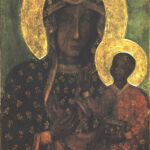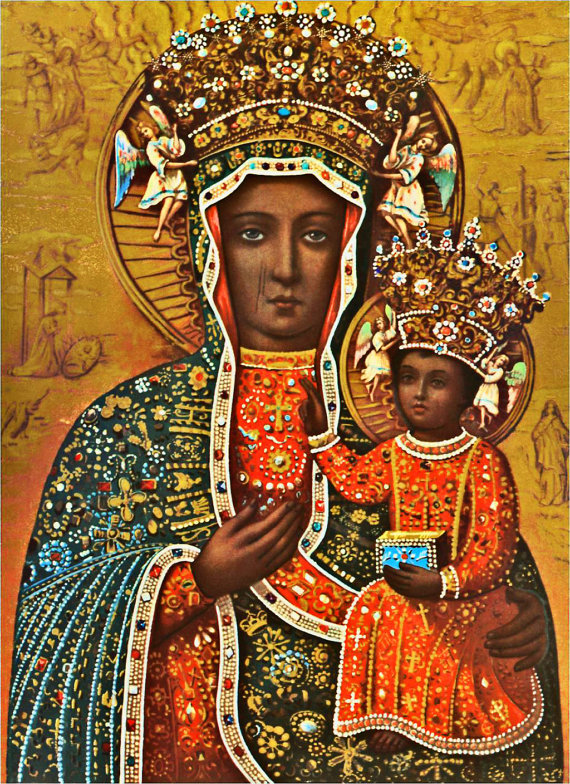
- Exploring the Origins of the Black Madonna in Catholic Tradition
- The Symbolism of the Black Madonna: Faith and Mysticism
- Is the Black Madonna a Catholic Icon? Understanding Its Role
- Cultural Significance of the Black Madonna in Catholicism
- Decoding the Black Madonna: Myths and Facts in Catholic Beliefs
- The Black Madonna: A Bridge Between Paganism and Catholicism
The Black Madonna is a figure shrouded in intrigue and reverence, often associated with various cultural and spiritual traditions. This enigmatic icon has generated a wealth of interpretations and discussions, leading many to ponder its true significance within the Christian faith.
In this exploration, we aim to provide insights into the complex relationship between the Black Madonna and Catholicism. By Decoding the Mystery: Is the Black Madonna Catholic?, we will examine historical contexts, artistic representations, and theological implications to better understand this captivating figure's place in religious practice.
Exploring the Origins of the Black Madonna in Catholic Tradition
The origins of the Black Madonna within Catholic tradition can be traced back to early Christian art and iconography. Often depicted as a dark-skinned figure of the Virgin Mary holding the Christ child, these images are believed to embody both divine and maternal qualities. Historical records suggest that many of these representations emerged in Europe, particularly during the medieval period, where they began to serve as symbols of comfort and protection for the faithful.
Many scholars propose that the Black Madonna may have roots in pre-Christian pagan traditions, where dark-skinned goddesses were worshipped. This syncretism highlights the adaptability of the Catholic Church in embracing local customs, which in turn enriched the tradition. Key aspects of the Black Madonna's significance include:
- Cultural Integration: Merging of indigenous beliefs with Catholicism.
- Symbol of Resistance: Representing resilience in times of adversity.
- Spiritual Protection: Many devotees seek her intercession for healing and guidance.
Geographically, the Black Madonna is prominent in various Catholic countries, with notable figures residing in France, Poland, and Spain. Each of these representations holds unique local narratives and veneration practices. For example, the Black Madonna of Czestochowa in Poland is celebrated as a national symbol, often associated with miraculous events and the country’s history of struggle.
Ultimately, the enduring legacy of the Black Madonna within Catholicism serves as a testament to her multifaceted identity. She encapsulates not only a profound spiritual presence but also a cultural bridge that connects diverse traditions. As such, the Black Madonna continues to captivate the hearts and minds of millions, inspiring ongoing dialogue about her role in both faith and society.
The Symbolism of the Black Madonna: Faith and Mysticism
The Black Madonna is not just a religious symbol; it represents a deep tapestry of faith and mysticism that resonates across various cultures. Central to this symbolism is her portrayal as a nurturing mother, embodying both the divine and the earthly aspects of femininity. This duality invites a rich dialogue about the nature of spirituality, as many devotees see her as a bridge between the sacred and the tangible world.
Furthermore, the mystical qualities attributed to the Black Madonna often stem from her association with miraculous events and healing powers. Many believers report profound experiences during pilgrimages to her shrines, suggesting that her presence invokes a deeper connection to the divine. Some key aspects of her mysticism include:
- Healing Powers: Stories of miraculous interventions in health crises.
- Visionary Experiences: Encounters that lead to personal transformations.
- Cultural Symbols: Representations of strength and resilience in adversity.
In many traditions, the Black Madonna serves as a powerful symbol of resistance, especially for marginalized communities who find empowerment and hope in her image. Her dark skin is often seen as a representation of the universality of the divine, transcending race and ethnicity. This aspect deepens the spiritual significance of the Black Madonna, affirming her role as a global icon of faith and unity.
Ultimately, the Black Madonna stands as a complex figure that invites believers to explore their own spiritual journeys. Through her symbolism, she challenges followers to embrace both their cultural identities and their quest for the sacred, making her a timeless emblem of faith and mysticism that continues to inspire countless individuals around the world.
Is the Black Madonna a Catholic Icon? Understanding Its Role
The Black Madonna holds a significant place in Catholicism as a powerful symbol that transcends mere iconography. While she is often categorized as a Catholic icon, her unique interpretations highlight the blend of cultural and spiritual elements that enhance her role. This duality prompts believers to reflect on the intersection of faith and identity, making her an enduring figure in both religious and social contexts.
In understanding the Black Madonna's role within Catholicism, it is essential to recognize the various attributes associated with her veneration. Some key aspects include:
- Protective Essence: Many devotees view her as a guardian figure offering solace and strength.
- Connection to the Divine: She is celebrated for her ability to bridge humanity and the sacred.
- Artistic Diversity: Her portrayals vary widely, reflecting local customs and traditions across different regions.
Moreover, the Black Madonna's significance extends beyond mere representation; she embodies a rich narrative of resilience and hope. Many pilgrims journey to her shrines, seeking not only healing but also a deeper understanding of their spiritual paths. This pilgrimage tradition highlights her role as a facilitator of personal transformation and communal unity.
As an icon, the Black Madonna invites ongoing dialogue about faith's multifaceted nature. Her presence encourages believers to explore their spiritual journeys, bridging cultural identities and prompting reflection on the universal qualities of motherhood and divine femininity. Thus, she remains a vital figure within the Catholic tradition, inspiring generations to seek deeper connections with their faith.
Cultural Significance of the Black Madonna in Catholicism
The cultural significance of the Black Madonna in Catholicism extends far beyond her artistic representation; she embodies the intersection of faith, identity, and community. Throughout history, she has emerged as a symbol of solace and strength for diverse groups, particularly marginalized communities who identify with her as a protector and intercessor. In many instances, her image fosters a sense of belonging, drawing individuals together in shared spiritual experiences and collective veneration.
Another vital aspect of the Black Madonna’s cultural relevance is her role as a maternal figure that transcends racial and ethnic boundaries. Her dark skin symbolizes a universal connection to the divine, inviting individuals from various backgrounds to find solace and inspiration in her image. This representation promotes inclusivity within the Church, encouraging discussions about the nature of divinity and the varying experiences of motherhood across cultures.
Moreover, numerous pilgrimages to the Black Madonna’s shrines illustrate her continuing importance in contemporary faith practices. During these journeys, devotees often report transformative experiences that deepen their spiritual connections. Key elements of this pilgrimage culture include:
- Personal Healing: Many seek her intercession for illnesses, believing in her miraculous powers.
- Cultural Celebration: Pilgrimages often coincide with local festivals, reinforcing community bonds.
- Spiritual Reflection: These journeys provide opportunities for personal growth and renewed faith.
Ultimately, the Black Madonna serves as a profound cultural icon within Catholicism, representing both the divine feminine and the resilience of humanity. Her significance is manifested in the stories, rituals, and artistic expressions that surround her, encouraging believers to explore their faith through the lens of their unique cultural experiences. As a result, she remains a vital source of inspiration that continues to resonate with individuals across the globe.
Decoding the Black Madonna: Myths and Facts in Catholic Beliefs
When examining the Black Madonna through the lens of Catholic beliefs, it becomes clear that she stands at the crossroads of tradition and innovation. Many myths surround her existence, often attributing her origins to ancient pagan deities or claiming her as a mere cultural adaptation. However, the truth reveals that the Black Madonna is a legitimate figure within Catholicism, embodying a unique blend of faith, culture, and spirituality that resonates deeply with many believers.
In the context of Catholic veneration, the Black Madonna is often revered not just for her physical representation but for the powerful narratives that accompany her. Key aspects of her role include:
- Spiritual Empowerment: She inspires many to seek strength and resilience in their faith journeys.
- Cultural Relevance: Her image reflects the diversity within the Church, fostering a sense of belonging for various communities.
- Miraculous Interventions: Numerous accounts of divine assistance through her intercession reinforce her significance among the faithful.
The theological implications of the Black Madonna are also significant. As a figure representing motherhood and divine compassion, she invites believers to explore their own identities and relationships with the sacred. Her image often challenges conventional representations of Mary, emphasizing a more inclusive understanding of femininity and divinity. This aspect of the Black Madonna's appeal draws individuals from various backgrounds into a shared experience of faith that transcends cultural barriers.
Ultimately, the Black Madonna serves as a bridge between historical tradition and contemporary spirituality within Catholicism. Her enduring presence in churches and shrines worldwide highlights her role as a symbol of hope and unity, reminding believers of the profound connections that exist across different cultures and experiences. This multifaceted identity continues to inspire countless individuals on their spiritual journeys, ensuring her legacy remains vital in the ever-evolving landscape of faith.
The Black Madonna: A Bridge Between Paganism and Catholicism
The Black Madonna serves as a fascinating bridge between paganism and Catholicism, illustrating how pre-Christian beliefs have been woven into the fabric of Christian faith. Many scholars argue that early representations of the Black Madonna were influenced by ancient goddesses revered for their nurturing and protective qualities. This syncretism not only enriched Catholic traditions but also allowed for a more inclusive understanding of spirituality that resonates with diverse communities.
One of the most compelling aspects of the Black Madonna's significance lies in her ability to connect various cultural narratives. Her portrayal often reflects local customs, making her a symbol of unity in the midst of diversity. Some key intersections between paganism and Catholicism embodied in her imagery include:
- Feminine Power: Celebrating the divine feminine that exists in both traditions.
- Earthly Connection: Acknowledging the importance of nature in spiritual practices.
- Ritual Practices: Shared elements of worship and veneration that transcend religious boundaries.
Furthermore, the Black Madonna’s role is not solely confined to religious symbolism; she also embodies cultural resilience. Often depicted as a figure of strength, her image has been embraced by marginalized groups seeking empowerment and hope. This duality reinforces her status as a cultural icon that resonates across time and space, inviting individuals to explore their spiritual roots while acknowledging the complexities of their identities.
Ultimately, the Black Madonna's multifaceted identity demonstrates her enduring significance in both pagan and Catholic contexts. As a transcendent figure, she encourages believers to reflect upon their spiritual journeys, fostering dialogue that bridges the gap between ancient traditions and contemporary faith. Through her story, the Black Madonna remains a powerful reminder of the interconnectedness of human experiences across cultural and religious landscapes.
 Unveiling the Mystery: Is the Volcano on Montserrat Still Active?
Unveiling the Mystery: Is the Volcano on Montserrat Still Active? Demystifying the Dress Code at Montserrat Monastery: What to Wear for a Spiritual Visit
Demystifying the Dress Code at Montserrat Monastery: What to Wear for a Spiritual Visit Exploring the Magic of Montserrat Monastery: A Spiritual Journey in Barcelona
Exploring the Magic of Montserrat Monastery: A Spiritual Journey in Barcelona The Black Madonna: Exploring the Patron Saint's Significance and Meaning
The Black Madonna: Exploring the Patron Saint's Significance and Meaning The Mystery Unveiled: Exploring the Miracle of the Black Madonna
The Mystery Unveiled: Exploring the Miracle of the Black MadonnaIf you want to know other articles similar to Decoding the Mystery: Is the Black Madonna Catholic? you can visit the category WHERE YOU CAN GO.
Deja una respuesta










Read more!